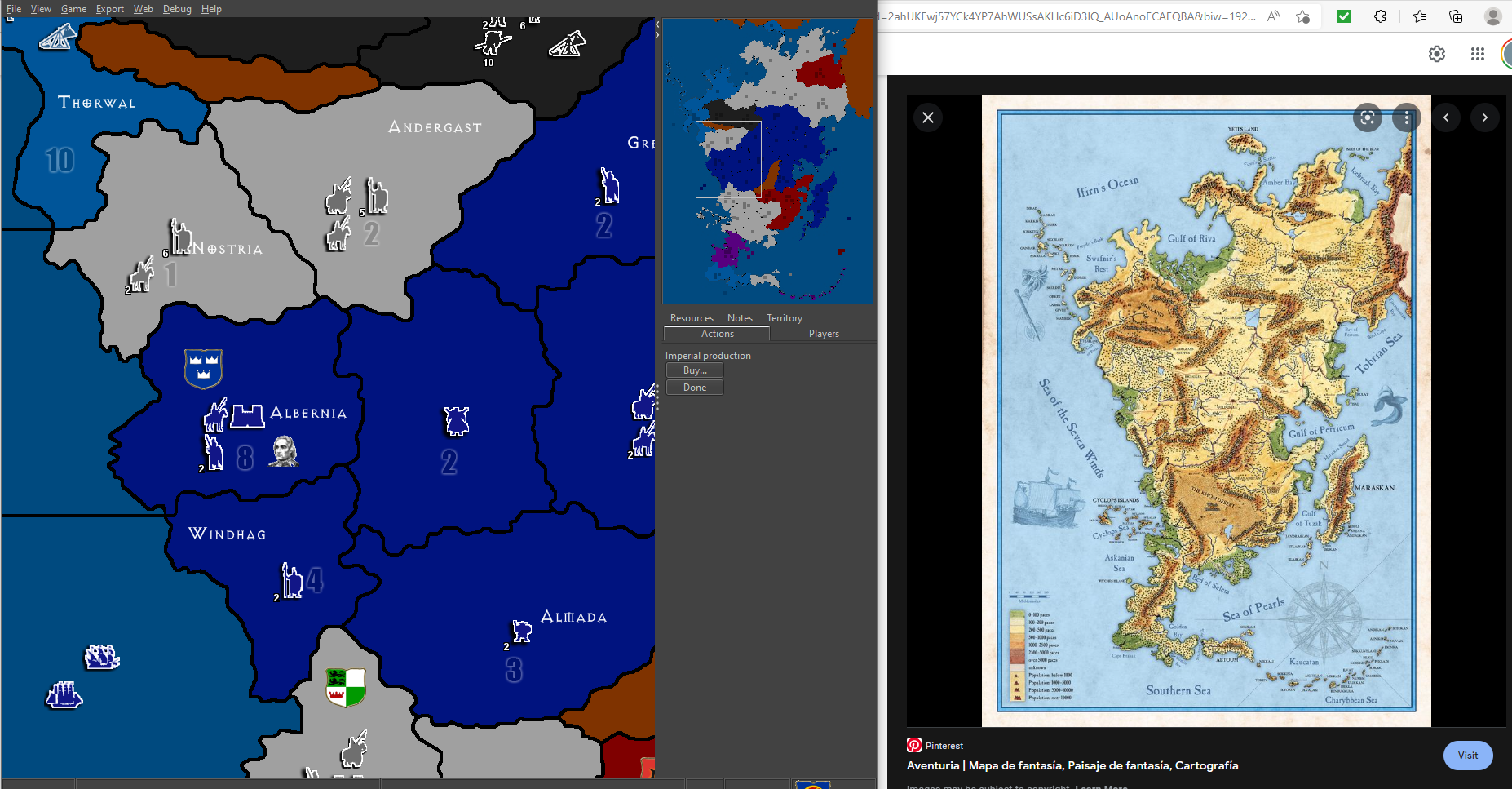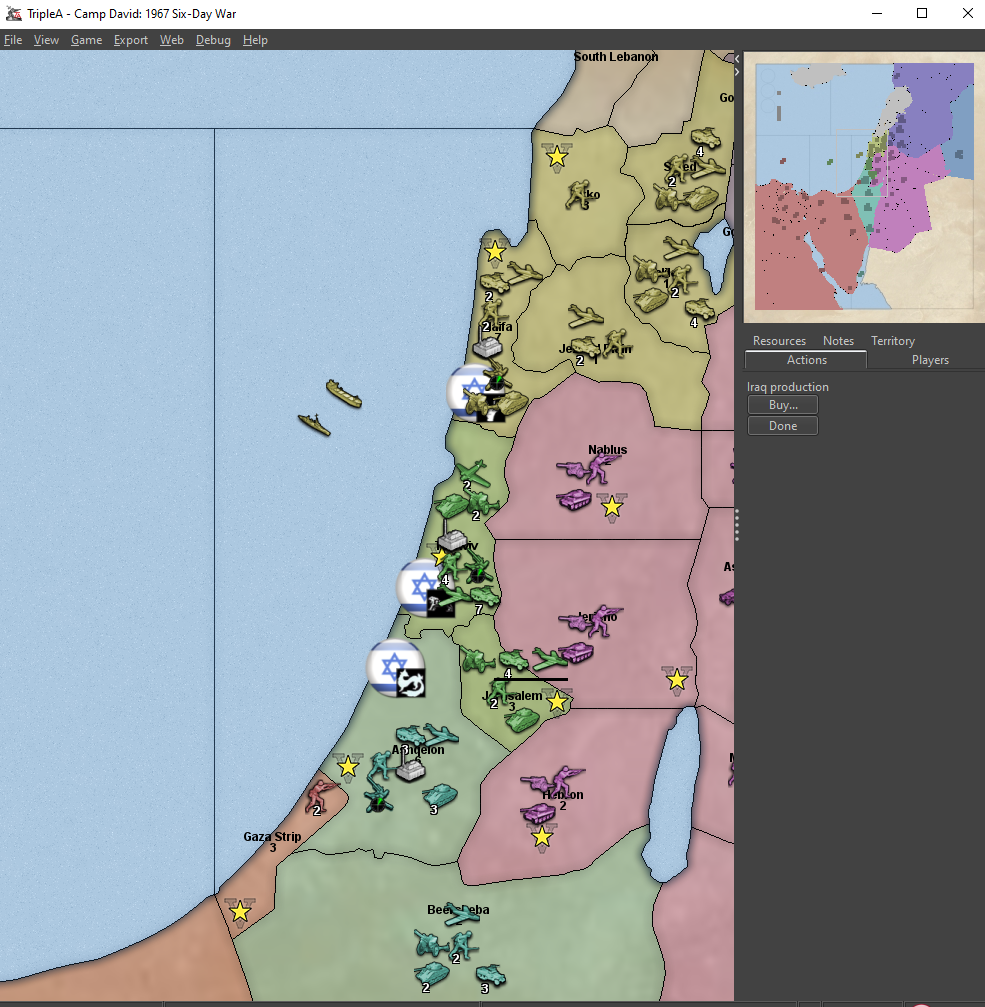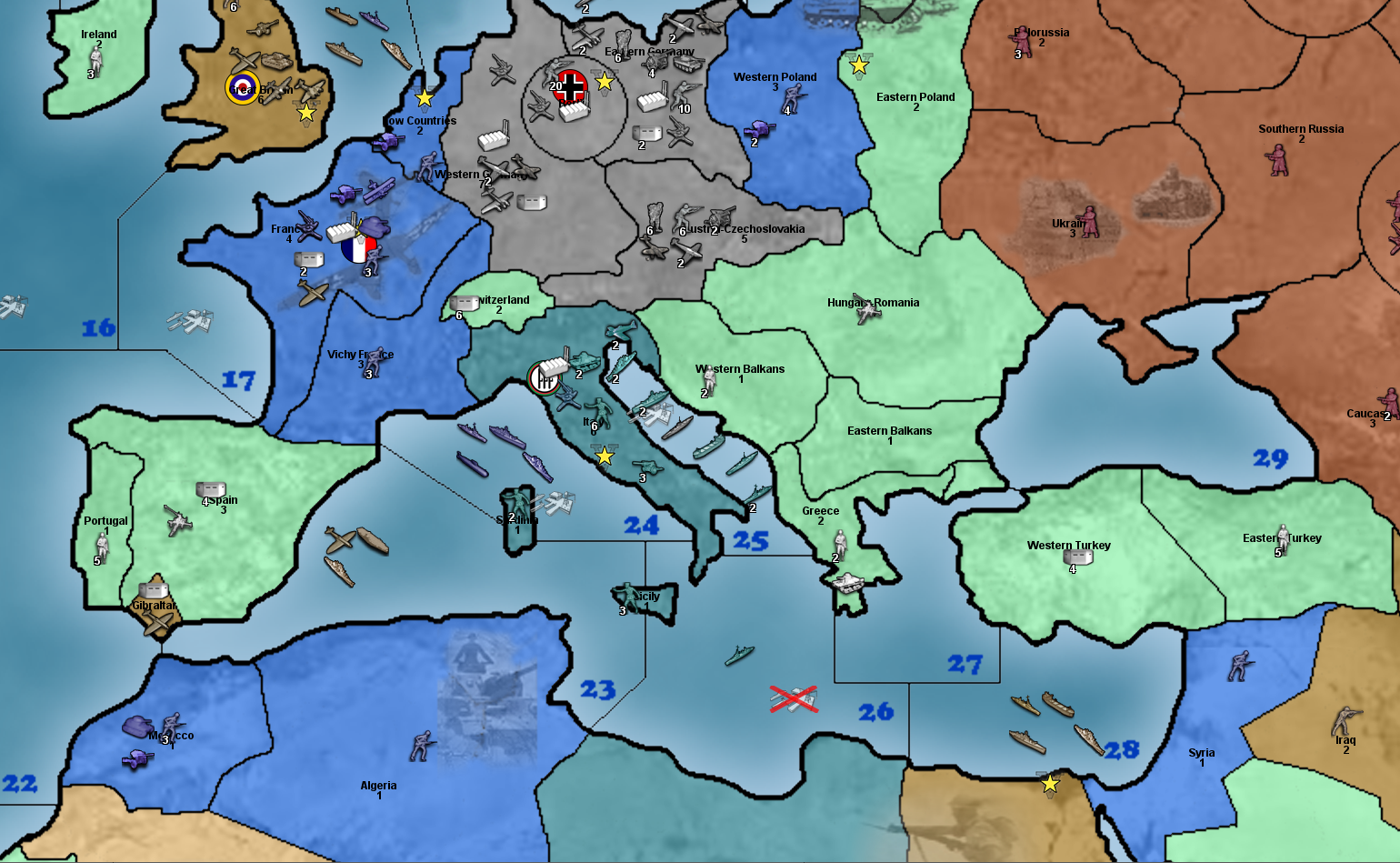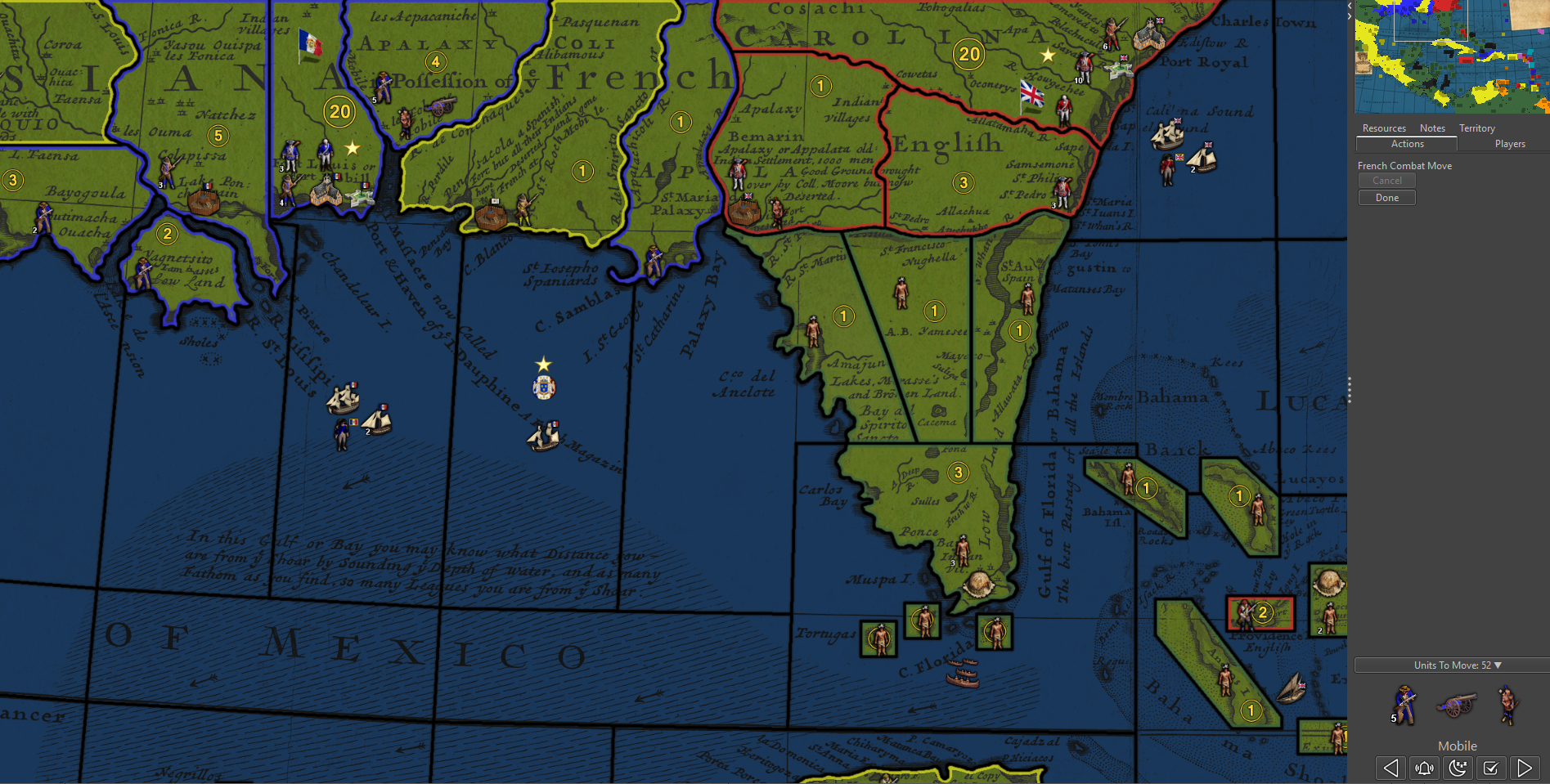PvP Scenario Review Thread
-
I play TripleA entirely PvP and am very grateful to all the developers evolving the engine and creating new maps. I am also doing a Masters in War Studies, with a focus on Wargaming, so I have an academic interest as well as entertainment.
The existing scenario thread has a greater focus on solo play and, for example, identifies where map complexity causes the AI to struggle. I wanted therefore to create a PvP thread with a different focus. This is not intended to be me alone - please can others post their own reviews, as I'm always grateful for a pointer towards maps I haven't played yet.
-
@mattbarnes
I would like you to play this, as its designed for multiplayer, it also has replay value as 3 of the startup TT are random, with 3 fixed per faction.
https://forums.triplea-game.org/topic/3146/the-shogun-official-threadIt has it all

But Im biased as I wrote it, you can turn the politics off for a true free for all or play it as intended with politics. It also looks good

Sadly I have not played it PvP.
-
Battle of Aventurica
by Nick TaylorBased on a fantasy literature and card game, called Aventuria in most regions, although there does seem to be an Adventurica wiki too. This theming, the map layout and the general-character pieces give a degree of immersion and entertainment. However, I'm not familiar with the underlying material so cannot comment on how faithful the map is.
This game has a relatively low degree of complexity, apparently using a subset of the unit types in one of the Lord of the Rings maps, and a relatively low number of territories compared to some of the more expansive TripleA maps. As such, it didn't convince us to replay.
The Imperial (dark blue) is the major player, with 2 (later 3) flanks to fight on, potentially benefiting from interior lines (ie to switch force from flank to flank in turn) and has the challenge of finding a way to concentrate enough to make progress in one direction without collapsing on other sides.
Thorwal (light blue), the only Imperial ally, is less interesting due to its relative weakness and peripheral position. Thorwal and the opposing Orcs (black) mainly play to-and-fro on the territories between them, with neither able to gain ascendency. Thorwal has the potential for interesting naval and amphibious interplay with the northern part of Borbarad (red) but both can generally enforce blockages at the 'canal' gap in the north, rendering any naval arms race likely to be inefficient compared to land development.
The Imperial and Thorwal territories in the south and east are indefensible, leaving little decision-making interest, although both players always have to consider utility of force, eg to extricate defenders allowing a quick loss, or contesting the lost cause more fully.
Borbarad's southern forces and AlArfa (purple) will wish to put pressure on the Imperial state as quickly as possible, as they are unit-rich and income-poor. My preference was to attack the neutrals as little as possible, as they are well-defended and offer insufficient income to quickly compensate for losses. I was able to quite quickly envelop the Imperials, balancing the income, then squeezing further. Borbarad in particular can produce effective air units in combination with cheap infantry fodder, giving an efficient mix. This left me feeling that the map is potentially disbalanced in Borbarad's favour.
However, Borbarad does suffer from its capital lying on a low-income territory, in a somewhat exposed location. This map inherits the base A&A rule where losing a capital carries severe penalties, potentially making that territory a make-or-break for a campaign. I am not sure whether this was an intentional feature to create a strategic issue, merely arose from the underlying literature, or was inadvertent. The implementation might benefit with a different capital rule.
The game was passably entertaining and could offer a base for further refinement if the author remains active in the community or another takes it up.

-
@thedog Thanks for engaging on this thread. And I have to say your graphics are beautiful and the Prologue screens are really nice.
Please bear with us though, as we're into another map at the moment, and each of our games takes weeks due to emailing a turn or two each week. If anyone else reads this thread in due course, they would be welcome to review your map if they get to it before me.
That said, I should add that I only play 1v1, whereas your map is designed for solo or for 12 player FFA. Therefore it does not really suit our norm. We would usually play with 2 alliances, like one might have done in the original A&A. Could you think whether your game would work well with fixed alliances of some sort?
Alternatively, we have played some maps by choosing one nation each, with the rest played by AI. This approach sometimes works well, sometimes quite badly - it can become a matter of "who can game the AI quicker or better". If you think this format could work for your map, could you playtest and recommend which 2 starting locations would work best for PvPvAI?
-
@mattbarnes said in PvP Scenario Review Thread:
If you think this format could work for your map, could you playtest and recommend which 2 starting locations would work best for PvPvAI?
Shimazu v Date v AI, that is two ends of the islands, is fairest, both have the same famed Samurai units. For your first game, both agree not to use Ninja, but the AI will. Dont lose your capital.
ps. Another option could be Amago v Oda v AI, you will start nearer to each other, have time to expand and then clash.
-
The Camp David maps
by Basile LemaireSpanning 25 years of Arab-Israeli conflict, this is a set of 4 scenarios with a common map and theme. The unit types and graphics are broadly the same throughout, although modifications reflect the development of technology between the first scenario (1948) and the last (1973 Yom Kippur), such as the appearance of jet planes.
There was enough in the setting and implementation to interest me in the game and in the background, inspiring some hours of historical reading. That said, I note Roger Cooper's thread comments that the scenarios do not represent the history too well.
Some of Israel's advantages are represented through TripleA's technology functionality: one cannot perform research in these scenarios, but some tech is preset to differentiate Israeli units from Arab units. I recall that at least one of these intentions did not operate properly in practice: the infantry are said to be transportable/mechanised but the vehicles are not capable of transporting. Several techs are live in the 1948 scenario that were probably only intended to apply to the later scenarios. And there are several other mismatches between the Notes and the implementation. The scenarios appear to have been written 12 years ago, and the TripleA engine has evolved since then.
Also, US aid to Israel in the last scenario is abstracted through the game's "convoy zones" functionality, effectively just delivering additional PUV.
The Arab nations are naturally presented as separate allied entities in the game. The author has smartly split the Israeli forces into three "Commands" which might loosely represent their real-life organisational structure but importantly aids playability. This employs the trademark feature of TripleA alliances which act as both advantage and constraint:. Israel's production and force is thus split across the nation, rather than being able to be fully concentrated. However, the Commands can benefit from co-operative "can-opener" moves [*] in a limited number of locations where they overlap.
Thought has also been put into the victory conditions, as the victory point locations, shown on the map with stars, differ between the scenarios, to fit the historical objectives. However, it would be useful if the Game Notes could identify the requisite number of victory points for a win, rather than this be inferred from the "Honorable Surrender" setup or simply discovered when achieved. The Game Notes also offer brief comments on historical setting and possible tactics for the players, but this could be enhanced.
In several of the scenarios, the key dynamic is that the strongest of the Arabs is Egypt, who is also the most remote. In terms of strategic play, this is a little alike the challenge the Allies have in getting USA involved in the WWII scenarios.
Each scenario is thoughtfully adapted to the circumstances of the nations in play and the hot spots contested, such as by use of impassable spaces. The scenarios also mostly seemed well-balanced for PvP, which is of course important for fun play, if not necessarily realistic. The first (1948), however, seemed to favour the Arab side materially so could benefit with an adjustment, or at least a recommended "bid" being suggested in the Notes.
The Suez Crisis scenario is the most different, employing British and French forces seeking to secure the canal with a strong army of fixed numbers - take too long or take too many casualties, then the Arabs will produce enough force to prevent the conquest.
The 1973 scenario allows Israel to play out its naval victory over Syria at the Battle of Lattakia, the 5v5 real-life missile boats represented here by 2 destroyers against 1. However, the setup seems to permit also an ahistorical amphibious capture of Lattakia itself.
Whilst I thoroughly enjoyed these scenarios, and played through all 4, they have not drawn me back for replays. The map is not huge, there's a small number of unit types, and the scenarios do not include some of the more complex features that I have grown to enjoy in other maps. However, I would still recommend the Camp David set to others, and they may inspire players to explore the history even if the scenarios themselves may not teach that history perfectly.
[*] most TripleA players will be familiar with this term: it arises where one nation attacks and captures a thinly-held enemy frontline territory, allowing its ally (assuming it has units that can move 2 spaces) to penetrate through that territory to attack a more critical enemy territory behind

-
@mattbarnes Good luck with your new thread.
-
deja vu no wai
-
Big World 2: Rise of the Axis
by Prussia (and others)This is a great WW2 map. It starts in 1939, with Germany, France and Britain at war, and Germany walking into Poland and the Axis taking neutral Balkans. (Starting game-map shown in image below.) There is otherwise a lot of flexibility about when other nations join the war. It is interesting, for example, for Italy to either join the Axis band-wagon as early as possible, or to defer entry and hence remain free of British attacks for a while. Similarly, Germany can attempt early Barbarossa, or build-up a bit more before invading Russia. In any case, the author makes France weak in order to ensure Germany can win its historical 1940 Battle of France. Russia have a one-turn special power to declare 'winter', stalling German attacks, and it's fun to decide when to pull that one out.
Japan need not declare against the Allies but is likely to do so in order to soak-up south-east Asia and Pacific islands. The only oddity here is that they must declare against the Allies as a whole, bringing USA into the conflict, and the Philippines invasion, 2 years early. I would have thought it within the engine functionality to include a separate mechanism for Japan-USA war independent of Japan-UK. Indeed Germany can defer conflict with the USA in the game, so Japan should be able to.
The author does try to inject a Pearl Harbour moment, materialising Yamamoto's carrier group mid-game and some sitting-duck Battleships for him to destroy. This rather blunt mechanic works surprisingly well, as long as Japan 'reads-ahead' to anticipate its arrival and positions adequate support.
There are numerous other theatrical features. I recommend reading the Game Notes thoroughly and revisiting them throughout the game. My opponent did not do so and therefore suffered some sub-optimal moments and other surprises. For example, Italy can send a unit to Germany to ask for an Afrika Korps appearance in Algeria. There are also copious Techs to think about and a lengthy list of National Objectives which are important to frame strategies around.
AA games have always struggled with modelling the Battle of the Atlantic and the map is no exception. Much of the Royal Navy is destroyed early-game but will likely later rebuild and overcome Axis ships. (I think it a mistake for Axis to try to compete at sea, diverting resources from land power.) Germany has a novel 'wolfpack' unit which acts as a mobile sea-factory, spawning a sub per turn. While feeling a bit ahistorical in its implementation, it does manage to drag-out the Atlantic battle for a historically realistic length of time.
Based on just a few PvP play-throughs, the game feels reasonably well-balanced, possibly slightly favoring Axis. Japan has significant prospects of thrusting through to Australia and Britain struggles to hold Egypt unless really focuses there, conceding elsewhere.
As I've mentioned on another thread, there is a Japanese one-shot kamikaze plane unit which doesn't appear to be working correctly as it auto-dies at the start of any battle. I have otherwise found the game to function very well.
There is also a sister map, 'Big World 2: Balance of Power". This starts in 1942, so many of the intricacies of 'Rise' have already resolved. All powers are at war and there are fewer strategic choices. As such, I don't think this offers additional play. However, it could be a good entry point - you could play 'Balance' first, to get a handle on some of the mechanics, before progressing to 'Rise' for the fuller experience.

-
Hi Mattbarnes,
Appreciate your comments here. To be clear, you are playing PvP on all these maps? Are you playing with friends or randoms online?
I've been playing some maps with some others and we are always looking out for well-balanced maps to play. Having this thread is useful to pool individual knowledge about maps for others to see.
You mention that the 1948 scenario for Camp David favours the Arabs. Is there a "bid" value that you suggest using to balance it out?
-
Hi @zoozoc. Most maps seem pretty balanced so far, with just that one exception I noted. I'm afraid it was quite a while ago so I can no longer remember well enough to recommend a bid. I just play against one family member. We always play a pair of games on any map, simultaneously, eg I'm Axis on one game and Allied in the other. That way at least if the map is unbalanced, we would each get the stronger side once. Also, if one side consistently wins by some margin it will indicate that a bid is required. However, we tend to only play a map 2-3 times, and the first game is usually full of errors, so we don't really have the data to be scientific about bids.
-
Thanks, good to know.
So far my group has mostly stuck with the pretty balanced and well-played WW2 maps. But venturing into less familiar maps, it is always a question whether a given map is balanced or not and usually you can only know by playing.
I'll post any notes or thoughts here about any interesting maps we play.
-
@mattbarnes I assume this is for 1 v 1 only right.
-
@board-3659 we normally play just PvP (2 player). But there are some fun PvPvAI maps, like Caribbean or Steampunk Advanced. We’ve also played some large player count ones, like a Japan/Shogun one, where we will choose to play a single faction each, with multiple AI between. I’m writing from memory here, but will try to review them in more detail in due course.
What we haven’t done is played with more than 2 humans, just cos it’s just the 2 of us. I expect the problem with multiple humans is that it becomes more about diplomacy than gameplay, and people get ganged-up on (unless you fix 2 teams).
-
Can I tempt you with this 1 v 1 map game?
Its a simple, low unit count, small map with lots of tactical opportunities.
Check this out;
https://forums.triplea-game.org/topic/3264/arena-of-death-official-threadPlay against a Fast AI to learn some of the tactics and then against a human.
-
When I play with my group, we still play fundamentally "1v1" games, it is just that each side is a team with a faction (or 2) played by one player. So in the classic WW2 formula, a separate player is playing Russia/Germany/UK/Japan/USA and it is 3v2 (or 2v2 with one player doubling up).
-
@mattbarnes steampunk advance imo should have one of the players be Nemo Pirates. AI isn't good with them. AI is ok with Martains but the best imo is AI Entente Central powers and the two players as the martains and nemo pirates. you could get 3 or 4 people if you want though
-
So I ended up play the "Aventurica" map with 3 other friends. Initially looking at the map, it seemed very skewed against the Imperials. So we decided to bid for the right to play "evil" with the bid value going to Thorwall (part of the imperial alliance) with the stipulation that units could only be placed up to the territory maximum (to allow for AlAnsa to have a good chance at capturing Brabak in the south).
(FYI, we always play "low luck" for all of the TripleA maps we play)
The bid ended up being 41 and I and a friend played as the Imperial allinace. It turns out that this map might actually be balanced or close to balanced at 0 bid because the game ended on turn 3 when it became apparent that the Imperial player would have no problem capturing Fasar (the capital of Borbarad player) with no way to prevent it.
If we had played the game as-is, it still seems like a very huge threat of Imperials taking Fasar because it has a limit of 2 production. By turn 5, Imperials would have had about a 28 unit surplus needed to take Fasar, so there is plenty of slack to defend their capital while sacking Fasar. Even with a 0 bid, it seems like Fasar could fall even with AlAnfa's support from the south, but maybe not.
The win condition for the Imperial alliance certainly seems to be taking Fasar without losing their own capital, while the other side wants to hold Fasar long enough so that their numerical advantage can be brought to bare against the Imperials.
I would like to retry the game with myself playing as "evil" with a much lower bid (maybe $15 for Thorwall) to see if I could make it work, but not sure if anyone else in my group wants to play this map again.
Here was the end-state on turn 3 at the start of the "orcs" turn in case anyone is interested in seeing it. lrx_aventurica_g1_orc3.tsvg
-
@zoozoc We played it 4 times, so I was Imperial twice and Borbarad twice. During the games my impression swung between at first thinking the map was strongly in favour of one side, then strongly for the other. Your observations, eg about the fragility of Borbarad's capital mirror mine. I think that, as you say, your Bid was rather too big. My sense that Evil has the advantage follows from being able to capture Brabak on turn 1 - you made that impossible. It would be interesting to use a Bid big enough to help Imperials but too small to delay Brabak's loss (or require the bid to be spent elsewhere). In that case, I think AlAnsa moves to support Fasar and the game is more interesting when the capture of Bornland opens a new front. The Imperials then need to look in two directions and struggle to concentrated sufficiently on Fasar.
-
Caribbean Trade War
by FrostionThis is a shorter review as my play of this map was some time ago and because the map plays quite ahistorically. However, the map was fun and reasonably balanced.
The scenario pits a French-Dutch-Danish alliance against a British-Spanish-Swedish. I understand that Sweden obtained a Caribbean colony in 1784 and there were several islands in the Danish West Indies. However, I sincerely doubt there is much accuracy in the alliances, relative strengths and game dynamics as presented here.
The Game Notes appear to anticipate a number of AIs playing key nations but we played as one human against the other, each playing a three-nation alliance. It remains however that the AI controls the indigenous warriors and some pirates. The latter can be instrumental if allowed to be - they are likely to grow to material strength and punish any smaller fleets or colonies. That said, the AI can become timid in later game, when the human strength exceeds theirs, almost like they fear to aggravate a stronger neighbour. A human may win if their human opponent fails to judge and anticipate the pirate actions.
Additional resources appearing from Europe is a fun dynamic. The Game Notes flag that this will happen but offer no details, so it is amusing to see the arrivals which are unexpected in timing and nature. However, these are pre-determined, not random, so can be anticipated in further games, and strategies adopted to optimise or defeat such reinforcements. Take care if your open is forewarned and you are not!
The map provides a number of theatres of combat on land and sea, sometimes between a single nation on each side, or sometimes operating in concert with allies, or disrupted by neutrals. This all generates plenty of interesting and fun battling.
